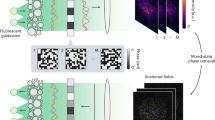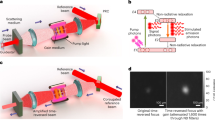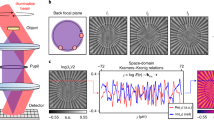Abstract
We theoretically investigated the sub-luminal and super-luminal light propagation by introducing compton scattering and Kerr non-linear effects to a four level atomic system. Slow light propagation is observed at a group index of 3918 in the transparency region. The slow light propagation is tuned to fast light propagation at group index 0.2, using compton scattering angle of \(\varphi =\pi /6\). The surperluminality is further enhanced with compton scattering angle at the resonance frequency. Under the Kerr nonlinearity, the slow light propagation at a group index of 3918 is enhanced to fast light propagation at group index of \(2\times 10^6\) at the resonance frequency. The group index is reduced to \(6.56281\times 10^{-5}\) in the presence of both Kerr non-linearity and compton scattering. In the presence of compton scattering, the Phase shift at \(\pi /2\) without Kerr nonlinearity is \(7\times 10^{-8}\) radian and with Kerr nonlinearity its value is \(1.7\times 10^{-9}\) radian at resonance frequency. This demonstrate that introducing Kerr effect and compton scattering lead to significant modifications in the phase shift.
Similar content being viewed by others
1 Introduction
The speed of light is one of the most important and core concept of optics. In a medium, the group velocity of light can exceed its speed in vacuum (superluminal propagation) or even become negative in a transparent material (Wang et al. 2000). The superluminal propagation is due to the anomalous dispersion in a medium and changing the group velocity of light to the superluminal propagation has attracted attention of researchers due to its wide range of applications in nonlinear optics (Harris and Hau 1999), photon controlling and storage (Liu et al. 2001), high-speed optical switching (Bajcsy et al. 2009), quantum communication (Duan et al. 2001) and precision sensing (Leonhardt and Piwnicki 2000). Light propagation in an optical medium can be manipulated by tailoring the dispersion properties of the medium. The control of dispersion from normal to anomalous can be obtained by applying a field connecting the two closed sublevels (Carreno et al. 2005). Wang et al. (2000) demonstrated superluminal light propagation using the region of lossless anomalous dispersion between two closely spaced gain lines in a double-peaked Raman gain medium. Kim et al. (2003) experimentally showed manipulation of light propagation from subluminal to superluminal propagation by changing the power of the pump field (laser) in a Cesium atomic system.
The phase sensitivity of a medium exhibit that how effectively this medium change the phase of incoming light beam. Evaluation of phase sensitivity allows us to quantify and understand how efficiently a medium responds to the incoming electromagnetic field. The change in phase is related to the change in refractive index of the medium. When a light beam passes through a medium, it induces a varying refractive index because of optical Kerr effect which leads to changes in its phase (Vaziri 2015). The phase sensitivity has great importance due to its potential applications in the field of quantum metrology, quantitative phase imaging and sensing (Kakue et al. 2011), gravitational wave detection (Vahlbruch et al. 2018), phase-shifting interferometry (Arif et al. 2021) and the study of protein structures. Phase sensitivity is deeply affected by internal losses inside the medium such as decoherence, photon absorption etc. The phase sensitivity can be characterized as spatial sensitivity which exhibit the non-uniformity within a region and temporal sensitivity that shows non-repeatability at a specific location. Both theoretical as well as experimental investigations have been made to study the phase sensitivity of different media. Non-classical states of light like Fock states, non-Gaussian states and squeezed entangled states have been used to estimate higher phase precession (Bradshaw et al. 2018). Chang et al. (2020) proposed a theoretical scheme and suggested that phase sensitivity could be enhanced by introducing a non-linear phase shifter within an interferometer. Recently, phase sensitivity have been studied through dynamic chiral medium under the quantum tunneling effect (Arif et al. 2021).
In this article, the superluminal propagation of light is investigated under compton scattering effect in the presence and absence of Kerr non-linearity. Furthermore, the phase shift is calculated in the presence of compton scattering with and without the Kerr non linearity. Upto the best of our knowledge, this is a new approach to control and modify the superluminity of light and phase shift. This work will play a significant role in development of phase-shifting digital holography, spatial light modulators, interferometry and increasing the capacity of storage devices. Furthermore, this work have applications in plasmonster technology which is based on control of surface plasmons sensitivity.
2 Model of the atomic system
We consider a four level atomic configuration as shown in Fig. 1. In this configuration, the electric probe field \(E_p\) which has Rabi frequency \(\Omega _p\) is coupled between states \(\left| 1\right\rangle\) and \(\left| 4\right\rangle\). The \(\left| 1\right\rangle\) and \(\left| 3\right\rangle\) are coupled with control field \(E_1\) having Rabi frequency \(\Omega _1\). The \(\left| 2\right\rangle\) and \(\left| 4\right\rangle\) are coupled with a control field \(E_2\) having Rabi frequency \(\Omega _2\). The decay rates between these states are \(\gamma _{1,2,3,4}\) and collision decay is \(\Gamma _1\). The detuning parameters of these fields are \(\Delta _1\), \(\Delta _2\) and \(\Delta _p\). The self Hamiltonian of the system is:
The Hamiltonian in the interaction picture can be written as:
The following master equation is used to solve the dynamics of the system:
where, \(R^\dagger\) is raising operator and R is lowering operator to determine the decay probability between the states. Using master equation and initial population condition, the following coherence is calculated after long algebraic calculations:
where \(A_{1-4}\) and Q are:
From the above coherence, the complex susceptibility is calculated, which is given below:
Here N is the atomic number density and \(\sigma _{14}\) is dipole matrix element. To introduce the cross Kerr non-linearity in the atomic system, the susceptibility \(\chi\) is expanded within the the following perturbation limit.
where \(\chi ^{(0)}\) is the Kerr field free susceptibility and \(I=|\Omega _1|^2\).
The group index without and with the presence of Kerr effect is given as:
The associated group velocity is written as \(v_g=c/n_g\) and \(v^{k}_g=c/n^{k}_g\). The complex refractive index after introducing the compton scattering effect can be written as:
The group index in the presence of compton effect can be written as:
The group index in the presence of both Kerr and compton effect can be written as:
The phase shift without compton and Kerr effects at length L can be written as:
The phase shift in the presence of Compton effect at the length L is written as:
The phase shift at the presence of Kerr effect at the length L can be written as:
The phase shift in the presence of both Kerr and compton effects at the length L can be written as:
All the above expressions have been used for our investigations. The obtained results are presented in the following section.
3 Results and discussions
The results are presented for susceptibility, group index and phase shifts both in the presence and absence of compton scattering effect. The atomic decay rate \(\gamma\) is assumed to be 1THz and other parameters are scaled to this decay rate. Atomic units are used throughout this work. The other frequencies parameters are scaled to this decay rate \(\gamma\) and therefore taken in atomic units. We take the value of \(\omega =1000\,\gamma\) and \(\lambda =2\pi c/\omega\).
In Fig. 2, the plots are traced for real and imaginary parts of susceptibility and group index of refraction without and in the presence of compton scattering effect. The real part of susceptibility show dispersion while imaginary part show absorption spectrum. The transparency window is measured at the given parameters and the slope of dispersion is found to be positive or normal within the transparency region as shown in Fig. 2a. The group index is positive within transparency region and have value of 3918 at resonance frequency \(\Delta _p=0\gamma\) as shown in Fig. 2b. The group index in the presence of compton scattering is 3918 at \(\varphi =0,2\pi\), but varies with value of \(\varphi\) from \(\pi /6\) to \(\pi\) radian as shown inset of Fig. 2c. In this case, the group index reduces to \(n^s_g=0.2\) at resonance frequency and the compton scattering angle \(\varphi =\pi /6\). The group index at detuning \(\Delta _p=0.1\gamma ,0.2\gamma ,0.3\gamma\) and \(\varphi =\pi /6\) is 0.13, 0.10 and 0.05 shown by dashed purple,dashed red, dashed green and dashed black lines as shown in Fig. 2c.
Figure 3 shows real and imaginary parts of susceptibility and group index of refraction in the presence of both Kerr and compton scattering effects. A narrow amplification window is measured at the given parameters and the slope of dispersion is positive within this narrow amplification around the resonance region. The negative absorption is called amplification. The group index is positive at the amplification region and enhanced to \(2.29\times 10^6\) at the resonance frequency in the presence of this cross Kerr nonlinearity. The group index plotted with compton scattering angle \(\varphi\) at resonance frequency is \(2.29\times 10^6\), when \(\varphi\) is 0 or \(2\pi\). The light pulse is sub-luminal when \(\varphi\) varies from zero to \(\pi\) radian. At \(\pi /6\) the group index \(n^s_g\) is \(6.56281\times 10^{-5}\). Further at \(\Delta _p=0.1\gamma\),we have \(n^s_g=9.5\times 10^{-4}\), while \(\Delta _p=0.2\gamma ,n^s_g=2.8\times 10^{-3}\) and \(\Delta _p=0.3\gamma , n^s_g=5.08\times 10^{-3}\).
Figure 4 show phase shifts with probe detuning. The phase shift is 1 milli-radian (inset red line) without Kerr nonlinearity, while it enhanced to 0.7 radian in the presence of Kerr effect at resonance frequency in the absence of compton scattering effect as shown in Fig. 4a. The phase shift under compton effect at \(\varphi =0,2\pi\) shows same value of 1 milli radian and 0.7 radian without compton as well as Kerr effect at resonance frequency. This show same phase shift according to close orbit theory of photon in matter from the scattering between two electrons at \(\varphi =\pi\). The phase shift decreases in the presence of compton effect and from without Kerr nonlinearity to the presence of Kerr nonlinearity. The phase shift at \(\pi /2\) without Kerr nonlinearity is \(7\times 10^{-8}\) radian and with Kerr nonlinearity is \(1.7\times 10^{-9}\) radian at resonance frequency in the presence of compton scattering as shown Fig. 4b, c.
In conclusion, the sub-luminal \(v_g<<c\) to super-luminal \(v_g>c\) propagation of light pulse and the phase shift is investigated in this article and significant tunability is reported. A group velocity of c/3918 in the transparency region without compton effect is obtained. This group index is reduced to 0.2 in the presence of compton scattering angle of \(\varphi =\pi /6\) at resonance frequency. By including the Kerr non-linearity, the slow group velocity of c/3918 is enhanced to \(c/2\times 10^6\). In the presence of both Kerr nonlinearity and compton scattering, the group velocity is tuned to \(c/6.56281\times 10^{-5}\). Significant modification in the phase shift is reported without and in the presence of Kerr nonlinearity and compton scattering effects. Phase shift at \(\pi /2\) without Kerr nonlinearity is \(7\times 10^{-8}\) radian and in the presence of Kerr nonlinearity, its value is \(1.7\times 10^{-9}\) radian at resonance frequency in the presence of compton scattering. In back-to-back electron scattering in a close orbit path, the same group index, group velocity and phase are obtained.
Data availibility
All the associated data with this study is present in the manuscript
References
Arif, S.M., Bacha, B.A., Wahid, U., Ullah, A., Haneef, M.: Tunable control of internet of things information hacking by application of the induced chiral atomic medium. Phys. Scr. 96, 035106 (2021)
Bajcsy, M., Hofferberth, S., Balic, V., Peyronel, T., Hafezi, M., Zibrov, A.S., Vuletic, V., Lukin, M.D.: Efficient all-optical switching using slow light within a hollow fiber. Phys. Rev. Lett. 102, 203902 (2009)
Bradshaw, M., Lam, P.K., Assad, S.M.: Ultimate precision of joint quadrature parameter estimation with a Gaussian probe. Phys. Rev. A 97, 012106 (2018)
Carreno, F., Calderon, O.G., Anton, M.A., Gonzalo, I.: Superluminal and slow light in \(\wedge\)-type three-level atoms via squeezed vacuum and spontaneously generated coherence. Phys. Rev. A. 71, 063805 (2005)
Chang, S., Wei, C., Zhang, H., Xia, Y., Yea, W., Hua, L.: Enhanced phase sensitivity with a nonconventional interferometer and nonlinear phase shifter. Phys. Lett. A 384, 126755 (2020)
Duan, L.M., Lukin, M.D., Cirac, J.I., Zoller, P.: Long-distance quantum communication with atomic ensembles and linear optics. Nature 414, 413–418 (2001)
Harris, S.E., Hau, L.V.: Nonlinear optics at low light levels. Phys. Rev. Lett. 82, 4611–4614 (1999)
Kakue, T., Yonesaka, R., Tahara, T., Awatsuji, Y., Nishio, K., Ura, S., Kubota, T., Matoba, O.: High-speed phase imaging by parallel phase-shifting digital holography. Opt. Lett. 36, 4131–4133 (2011)
Kim, K., Moon, H.S., Lee, C., Kim, S.K., Kim, J.B.: Observation of arbitrary group velocities of light from superluminal to subluminal on a single atomic transition line. Phys. Rev. A 68, 013810 (2003)
Leonhardt, U., Piwnicki, P.: Ultrahigh sensitivity of slow-light gyroscope. Phys. Rev. A. 62, 055801 (2000)
Liu, C., Dutton, Z., Behroozi, C.H., Hau, L.V.: Observation of coherent optical information storage in an atomic medium using halted light pulses. Nature 409, 490–493 (2001)
Vahlbruch, H., Wilken, D., Mehmet, M., Willke, B.: Quantum correlation measurement of laser power noise below shot noise. Phys. Rev. Lett. 121, 173601 (2018)
Vaziri, M.R.R.: Comment on “Nonlinear refraction measurements of materials using the moiré deflectometry’’. Opt. Commun. 357, 200–201 (2015)
Wang, L.J., Kuzmich, A., Dogariu, A.: Gain-assisted superluminal light propagation. Nature 406, 277 (2000)
Wang, L.J., Kuzmich, A., Dogariu, A.: Gain-assisted superluminal light propagation. Nat. Lond. 407, 277 (2000)
Funding
There is no funding involved in this research
Author information
Authors and Affiliations
Contributions
The first and second authors were involved in the calculations and analysis. The 3rd, 4rth and 5th author were involved in writing the manuscript, refining the results and discussions. All the authors equally contributed in reviewing the paper
Corresponding author
Ethics declarations
Competing interests
There are no conflict of interest
Ethical approval
There is no ethical approval required for this research work
Additional information
Publisher's Note
Springer Nature remains neutral with regard to jurisdictional claims in published maps and institutional affiliations.
This article is part of the Topical Collection on Recent Advances of Advanced Functional Materials for Optics, Lasers and Photovoltaics Applications, Guest edited by Oksana Krupka, Anna Zawadzka, Hassane Erguig, Alexander Quant and Bouchta Sahraoui.
Rights and permissions
Open Access This article is licensed under a Creative Commons Attribution 4.0 International License, which permits use, sharing, adaptation, distribution and reproduction in any medium or format, as long as you give appropriate credit to the original author(s) and the source, provide a link to the Creative Commons licence, and indicate if changes were made. The images or other third party material in this article are included in the article's Creative Commons licence, unless indicated otherwise in a credit line to the material. If material is not included in the article's Creative Commons licence and your intended use is not permitted by statutory regulation or exceeds the permitted use, you will need to obtain permission directly from the copyright holder. To view a copy of this licence, visit http://creativecommons.org/licenses/by/4.0/.
About this article
Cite this article
Akbar, J., Bin, X., Hou, L. et al. Phase sensitivity by fast light propagation using compton scattering and Kerr non-linearity. Opt Quant Electron 55, 129 (2023). https://doi.org/10.1007/s11082-022-04334-y
Received:
Accepted:
Published:
DOI: https://doi.org/10.1007/s11082-022-04334-y








